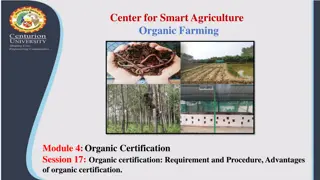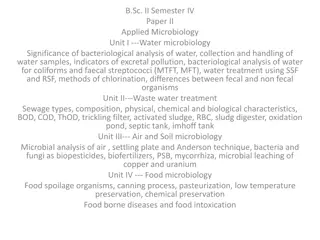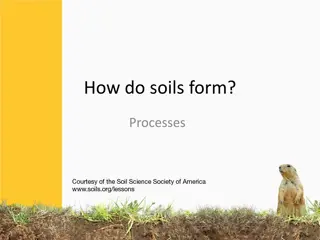Understanding Composition of Soil Organic Matter in Soil Microbiology
Soil organic matter is vital for soil properties and plant nutrition. It consists of plant residues, animal remains, and microbial tissues, comprising complex compounds like carbohydrates, proteins, fats, and more. The composition varies with plant type, age, and nature. Leguminous plants are rich in proteins, while grasses contain higher amounts of cellulose and lignin. Understanding the components of organic matter is crucial for soil health and plant growth.
Download Presentation

Please find below an Image/Link to download the presentation.
The content on the website is provided AS IS for your information and personal use only. It may not be sold, licensed, or shared on other websites without obtaining consent from the author. Download presentation by click this link. If you encounter any issues during the download, it is possible that the publisher has removed the file from their server.
E N D
Presentation Transcript
Soil Microbiology Third year botany 307B Lecture 8 Dr. Mahmoud Nour El-Dein
Composition of Organic Matter Soil organic matter plays important role in the maintenance and improvement of soil properties. It is a dynamic material and is one of the major sources of nutrient elements for plants. Soil organic matter is derived to a large extent from residues and remains of the plants together with the small quantities of animal remains, excreta, and microbial tissues.
Soil organic matter is composed of three major components i.e. plants residues, animal remain and dead remains of microorganisms. Various organic compounds are made up of complex carbohydrates, ( Cellulose, hemicellulose, starch) simple sugars, lignin's, pectin's, gums, mucilage's, proteins, fats, oils, waxes, resins, alcohols, organic acids, phenols and other products. All these compounds constituting the soil organic matter can be categorized in the following way:
Organic Matter (Undecomposed) Organic: Nitrogenous: Non-Nitrogenous: Insoluble e.g. Proteins nucleoprotein s, peptides, alkaloids purines, pyridines chitin etc. Water Soluble e.g. Nitrates, ammoniacal compounds, amides, amino acids etc. Miscellaneous: e.g. Lignin, tannins, organic acid, etc. Carbohydrates e.g. Sugars, starch, hemicellulose, gums, mucilage, pectin's, etc. Ether Soluble: e.g. Fats, oils, wax
Inorganic The organic complex in the soil is, therefore made up of a large number of substances of widely different chemical composition and the amount of each substance varies with the type, nature and age of plants. For example cellulose in a young plant is only half of the mature plants; water-soluble organic substances in young plants are nearly double to that of older plants.
Among the plant residues, leguminous plants are rich in proteins than the non-leguminous plants. Grasses and cereal straws contain greater amount of cellulose, lignin, hemicelluloses than the legumes and as the plant gets older the proportion of cellulose, hemicelluloses and lignin gets increased. Plant residues contain 15-60% cellulose, 10-30 % hemicelluloses, 5-30% lignin, 2-15 % protein and 10% sugars, amino acids and organic acids.
These differences in composition of various plant and animal residues have great significance on the rate of organic matter decomposition in general and of nitrification and humification (humus formation) in particular. The end products of decomposition are CO2, H2O, NO3, SO4, CH4, NH4, and H2S
Factors Influencing Rate of Organic Matter Decomposition. In addition to the composition of organic matter, nature and abundance of microorganisms in soil, the extent of C, N, P and K., moisture content of the soil and its temperature, pH, aeration, C: N ratio of plant residues and presence/absence of inhibitory substances (e.g. tannins) etc. are some of the major factors which influence the rate of organic matter decomposition.
As soon as plant and animal residues are added to the soil, there is a rapid increase in the activity of microorganisms. These are not true soil organisms, but they continue their activity by taking part in the decomposition of organic matter and thereby release of plant nutrients in the soil. Bacteria are the most abundant organisms playing important role in the decomposition of organic matter.
Majority of bacteria involved in decomposition of organic matter are heterotrophs and autotrophs are least in proportion which are not directly involved in organic matter decomposition. Actinomycetes and fungi are also found to play important role in the decomposition of organic matter. Soil algae may contribute a small amount of organic matter through their biomass but they do not have any active role in organic matter decomposition.
a- Aeration: Good aeration is necessary for the proper activity of the microorganisms involved in the decomposition of organic matter. Under anaerobic conditions fungi and actinomycetes are almost suppressed and only a few bacteria (Clostridium) take part in anaerobic decomposition. The rate of decomposition is markedly retarded. It was found that under aerobic conditions 65 % of the total organic matter decomposes during six months, while under anaerobic conditions only 47 % organic matter can be decomposed during the same period.
Anaerobic decomposition of organic matter results into the production of large quantity of organic acids and evolution of gases like methane (CH 4) hydrogen (H2) and carbon dioxide (CO2). Anaerobic decomposition of organic matter results into the production of large quantity of organic acids and evolution of gases like methane (CH 4) hydrogen (H2) and carbon dioxide (CO2).
b) Temperature: The rate of decomposition is more rapid in the temperature range of 30 to 40 ' At temperatures below or above this range, the rate of decomposition is markedly retarded. Appreciable organic mater decomposition occurs at 25 C and further fluctuation in the soil temperature has little effect on decomposition.
c) Moisture: Adequate soil moisture i.e. about 60 to 80 percent of the water- holding capacity of the soil is must for the proper decomposition of organic matter. Too much moisture leads to insufficient aeration which results in the reduced activity of microorganisms and there by checks the rate of decomposition
d) Soil pH/soil reaction: Soil pH affects directly the kind, density and the activity of fungi, bacteria & actinomycetes involved in the process of decomposition and thereby rate of decomposition of organic matter. The rate of decomposition is more in neutral soils than that of acidic soils. Therefore, treatment of acid soils with lime can accelerate the rate of organic matter decomposition.
e) C: N ratio: C: N ration of organic matter has great influence on the rate of decomposition. Organic matter from diverse plant-tissues varies widely in their C: N ratio (app. 8-10 %). The optimum C: N ratio in the range of 20- 25 is ideal for maximum decomposition, since a favorable soil environment is created to bring about equilibrium between mineralization and immobilization processes. Thus, a low nitrogen content or wide C: N ratio results into the slow decomposition.
Protein rich, young and succulent plant tissues are decomposed more rapidly than die protein-poor, mature and hard plant tissues. Therefore, C:N ratio of organic matter as well as soil should be narrow for better and rapid decomposition. Thus, high aeration, mesophilic temperature range, optimum moisture, neutral/alkaline soil reaction and narrow C: N ratio of soil and organic matter are required for rapid and better decomposition of organic matter.























